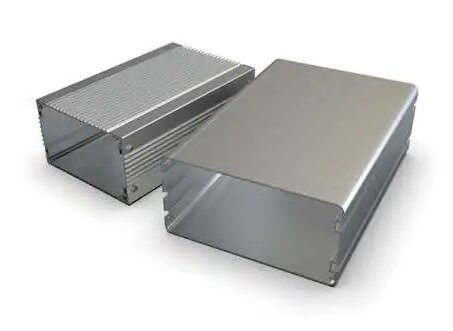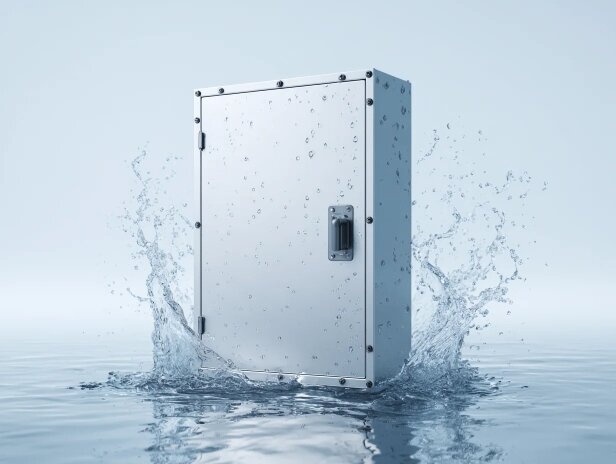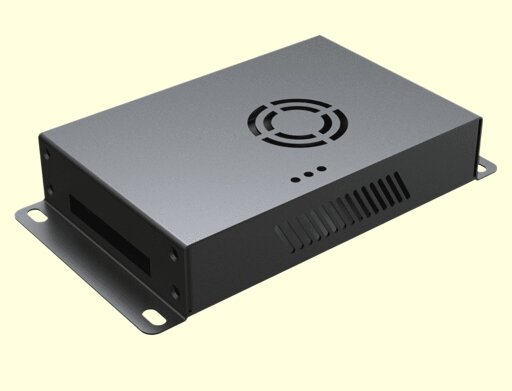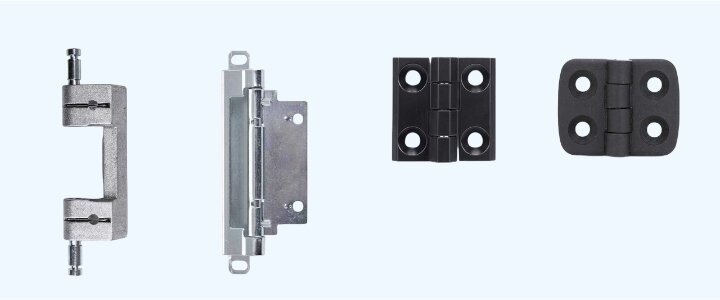많은 엔지니어와 작업장 관리자는 고르지 않은 나사 모양이나 특수한 나사 크기가 필요한 문제를 해결해야 합니다. 표준 도구로 문제를 해결할 수 없을 때는 더욱 힘들어집니다. 하지만 싱글 포인트 스레딩을 사용하는 방법을 배우면 도움이 될 수 있습니다. 프로세스를 더 잘 제어할 수 있습니다. 정확한 필요에 맞게 스레드를 절단할 수 있습니다.
단일 포인트 스레딩을 사용하면 사용자 지정 스레드를 자르고, 프로파일을 조정하고, 정확한 사양을 충족할 수 있습니다. 이 가이드에서는 프로세스를 세분화하고, 작동 방식을 설명하며, 모범 사례를 다룹니다.
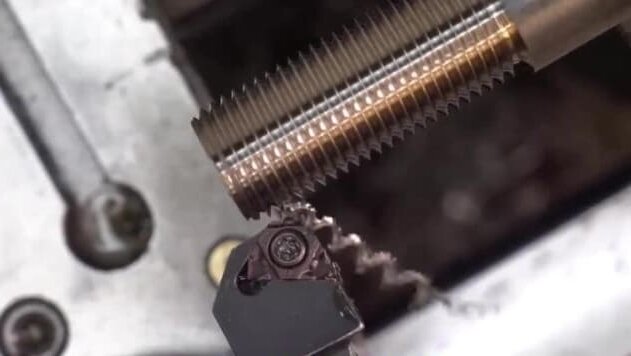
싱글 포인트 스레딩이란 무엇인가요?
단일 포인트 스레딩은 절삭 공구를 사용하여 공작물에 스레드를 생성하는 방법입니다. 나사산 프로파일과 같은 모양의 하나의 공구를 사용합니다. 선반에서 부품이 회전하면 공구가 부품을 따라 이동하면서 나사산을 절단합니다. 이 절단은 천천히 단계적으로 이루어집니다.
이 방법은 수동 선반과 CNC 터닝 머신. 부품의 외부 또는 내부에 스레드를 만들 수 있습니다. 주요 장점 중 하나는 제어입니다. 디자인에 따라 스레드 크기, 모양 및 피치를 선택할 수 있습니다.
이 과정에서 도구는 전체 실을 한 번에 자르지 않습니다. 여러 번 통과합니다. 각 패스마다 도구가 조금씩 더 깊숙이 들어갑니다. 이 과정은 실이 최종 깊이에 도달할 때까지 계속됩니다. 이는 한 번에 실을 자르는 탭이나 다이와는 다릅니다.
싱글 포인트 스레딩도 유연합니다. 스레드 크기나 모양을 쉽게 변경할 수 있습니다. 따라서 맞춤형 부품, 수리 작업 또는 소량 배치에 적합합니다. 특수 나사산이 필요하거나 꼭 맞아야 할 때 유용합니다. 또한 품질과 정확성을 더 잘 제어할 수 있습니다.
생성된 스레드 유형
단일 포인트 스레딩을 사용하면 다양한 스레드 유형을 유연하게 만들 수 있습니다. 사용자 지정 사양이나 특정 스레드 표준에 맞춰야 할 때 유용합니다. 이 섹션에서는 이를 자세히 설명합니다.
내부 스레드와 외부 스레드
외부 나사산은 볼트나 샤프트와 같이 부품의 외부에서 절단됩니다. 나사 가공 공구는 회전하는 공작물의 외경을 따라 이동하며 완전한 나사산 형태에 도달할 때까지 서서히 절삭합니다.
내부 나사산은 너트나 하우징과 같은 구멍 내부에서 절단됩니다. 이를 위해서는 동일한 프로파일을 가진 더 작은 공구가 필요합니다. 공구가 보어 내부에서 작동하기 때문에 공간과 가시성이 제한되기 때문에 더 어렵습니다.
두 유형 모두 세심한 정렬과 깊이 제어가 필요합니다. 설정이나 공구 경로에서 실수가 발생하면 나사산 맞춤이나 강도에 영향을 미칠 수 있습니다.
공통 스레드 표준
산업마다 서로 다른 나사산 표준을 사용합니다. 단일 포인트 스레딩을 사용하면 공구와 기계가 올바르게 설정되어 있는 한 거의 모든 스레드를 유연하게 절단할 수 있습니다.
미터법 스레드
미터법 스레드는 전 세계적으로 널리 사용되고 있습니다. 밀리미터 단위로 측정됩니다. 중심값은 기본 직경과 스레드 사이의 거리인 피치입니다.
예를 들어, M10 × 1.5는 스레드의 기본 직경이 10mm이고 피치가 1.5mm임을 의미합니다. 미터법 스레드는 ISO 표준을 따르므로 공급업체 간에 일관성이 보장됩니다.
통합 스레드 표준(UTS)
UTS는 미국에서 일반적입니다. 밀리미터 대신 인치를 사용합니다. 피치는 종종 인치당 스레드 수(TPI)로 표시됩니다.
예를 들어 1/4-20 UNC 스레드는 직경 1/4인치, 인치당 20개의 스레드를 의미합니다. UNC는 통합 굵은 나사산을 의미합니다. UNF(미세)와 UNEF(엑스트라 미세)도 있습니다.
각 표준에는 피치, 각도 및 깊이에 대한 고유한 규칙이 있습니다. 스레딩 도구는 형태와 크기가 정확히 일치해야 합니다.
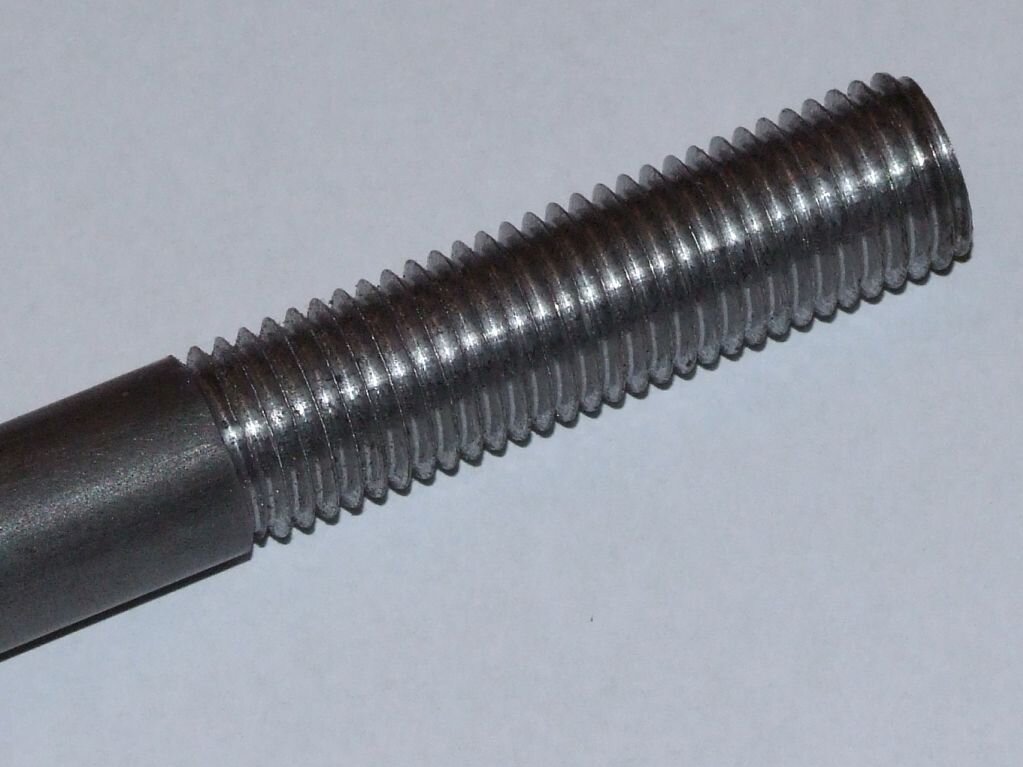
싱글 포인트 스레딩을 위한 도구 및 장비
싱글 포인트 스레딩을 수행하려면 올바른 기계와 절삭 공구가 필요합니다. 설정은 스레드의 유형, 재료 및 결과물의 정밀도에 따라 달라집니다.
선반 기계와 그 역할
단일 포인트 스레딩은 항상 선반에서 이루어집니다. 선반은 공작물을 회전시키면서 절삭 공구가 공작물을 따라 직선으로 이동합니다. 이 동작이 결합되어 나사산이 만들어집니다.
수동 선반은 리드 스크류와 기어를 사용하여 나사산 피치를 맞춥니다. 작업자는 기어를 설정하거나 정확한 이송 속도를 다이얼로 조정합니다. CNC 선반은 프로그래밍된 설정을 통해 자동으로 이 작업을 수행합니다. 더 빠르고 반복할 수 있습니다.
스레딩 도구의 유형
스레딩 도구가 절단을 수행합니다. 실의 모양과 일치하는 날카로운 모서리가 있습니다. 가장 일반적인 유형은 다음과 같습니다:
- HSS(고속 강철) 도구: 작은 작업과 부드러운 재료에 적합합니다. 다양한 모양으로 연마할 수 있습니다.
- 카바이드 인서트: 더 단단한 소재나 장시간 사용 시 사용합니다. 더 오래 지속되고 표면 마감이 더 좋습니다.
- 보링바: 내부 실을 자를 때 사용합니다. 내부 구멍에 맞으며 나사산 도구 모양입니다.
도구 지오메트리 및 삽입 유형
스레딩 도구에는 지오메트리라는 특정 모양이 있습니다. 주요 기능은 다음과 같습니다:
- 스레드 프로필: 실의 모양과 일치합니다. 예를 들어 미터법 또는 UNC 스레드의 경우 60° V자 모양입니다.
- 코 반경: 실의 문장 모양을 제어하는 작고 둥근 팁입니다. 너무 날카로우면 부서질 수 있고 너무 둥글면 디테일이 흐려질 수 있습니다.
- 릴리프 각도: 절단할 때 도구가 재료를 문지르지 않도록 합니다.
단계별 단일 포인트 스레드 절단 프로세스
나사 절삭은 세심한 설정과 안정적인 제어가 필요합니다. 실수와 공구 손상을 방지하려면 다음 순서를 따르세요.
1단계: 공작물 및 기계 준비하기
먼저 공작물 크기와 재질을 확인합니다. 공작물이 둥글고 깨끗하며 척에 단단히 고정되어 있는지 확인합니다. 공작물이 흔들리면 나사산이 정확하지 않습니다.
선반을 청소하고 공구 간격을 확인합니다. 칩을 제거하고 기계를 올바른 속도로 설정합니다. 일반 선삭보다 느린 RPM을 사용합니다.
2단계: 올바른 스레드 매개변수 선택
나사산 피치, 직경 및 나사산 형태를 결정합니다. 이는 도면 또는 부품 설계에 따라 다릅니다. 공구가 나사산 프로파일과 일치하는지 확인합니다.
나사산 피치에 맞게 이송 속도를 설정합니다. 예를 들어 1.5mm 피치는 스핀들 회전당 공구가 1.5mm 이동해야 합니다.
CNC 선반을 사용하는 경우 프로그램에서 모든 나사산 매개변수를 입력합니다. 코드가 정확한지 다시 확인하세요.
3단계: 도구 설치 및 정렬
공구 홀더에 나사산 공구를 장착합니다. 절삭 날은 부품을 정면에서 바라보고 중앙 높이에 있어야 합니다. 중심 게이지를 사용하여 공구를 올바른 각도(일반적으로 대부분의 나사산에 대해 60°)로 정렬합니다.
도구가 단단히 고정되었는지 확인하세요. 움직이면 실 모양에 영향을 미칩니다.
4단계: 영점 기준 설정
공구를 공작물 가까이로 이동합니다. 표면을 터치 오프하고 X축을 0으로 설정합니다. 그런 다음 약간 뒤로 물러나서 Z축 시작점을 설정합니다.
이 참조는 기계가 각 패스를 시작할 위치를 알려줍니다. 0이 꺼져 있으면 나사산 깊이와 위치가 사양과 일치하지 않습니다.
수동으로 작업하는 경우 스레드 다이얼 또는 동기화 방법을 사용합니다. CNC 기계의 경우 공구 경로가 올바른 위치에서 시작되는지 확인합니다.
5단계: 첫 번째 스레딩 패스 만들기
선반을 시작하고 이송을 맞물립니다. 공구가 나사산 피치에 따라 얕은 홈을 절단해야 합니다. 부드러운 동작과 깔끔한 절삭을 확인하세요.
공구 과부하를 방지하기 위해 가벼운 절삭 깊이를 사용합니다. 첫 번째 패스가 끝나면 기계를 멈추고 나사산 형태를 확인합니다.
스레드 피치 게이지 또는 현미경을 사용하여 피치와 모양이 올바른지 확인합니다.
6단계: 깊이 조정으로 커팅 패스 반복하기
더 깊은 패스로 계속 자릅니다. 실이 최종 크기에 가까워지면 매번 깊이를 줄이세요. 이렇게 하면 절삭력이 줄어들고 표면이 매끄럽게 유지됩니다.
절삭유를 도포하여 열을 낮추고 공구 수명을 개선합니다. 칩이 쌓이는지 관찰하고 필요한 경우 속도 또는 이송을 조정합니다.
몇 번 통과한 후 멈추고 잘 맞는지 확인합니다. 나사 게이지 또는 테스트 부품을 사용합니다. 스레드가 올바른 깊이와 핏에 도달하면 중지합니다.
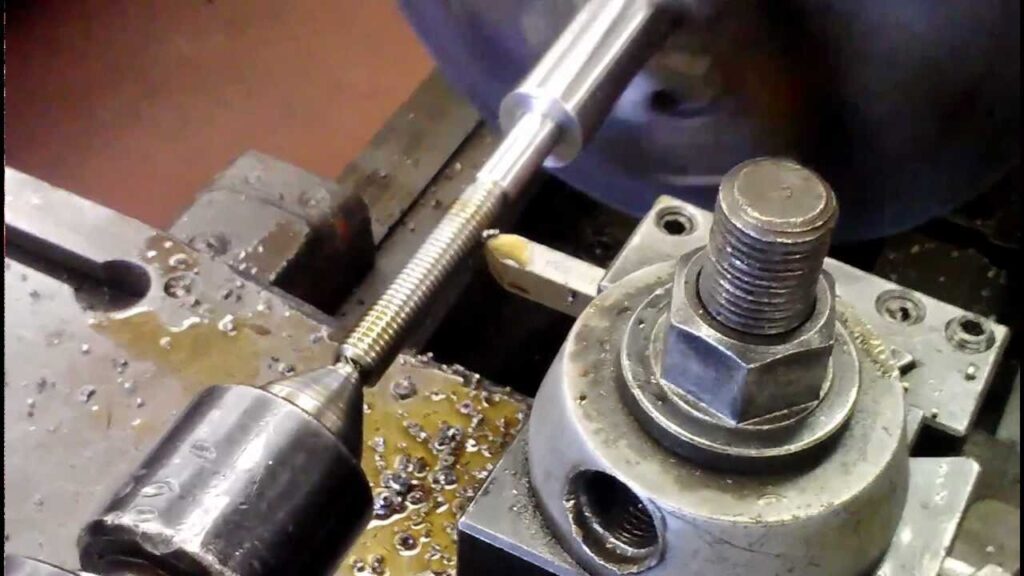
싱글 포인트 스레딩의 장점
싱글 포인트 스레딩은 더 나은 제어와 유연성을 제공하기 때문에 여전히 널리 사용되고 있습니다. 실제 매장 환경에서 싱글 포인트 스레딩이 확실한 선택인 이유는 다음과 같습니다.
정밀도와 정확성
이 방법을 사용하면 스레드 크기와 모양을 강력하게 제어할 수 있습니다. 기계에서 피치, 깊이 및 형태를 바로 설정할 수 있습니다. 엄격한 공차가 필요한 부품에 적합합니다. 실을 자르고, 확인하고, 딱 맞을 때까지 조금씩 변경할 수 있습니다.
다양한 스레드 유형에서 작동
단일 포인트 스레딩을 사용하여 거의 모든 유형의 스레드를 절단할 수 있습니다. 미터법, 통합, ACME, 사다리꼴, 사용자 지정 형상까지 처리할 수 있습니다. 올바른 공구 모양과 기계 설정이 필요합니다.
소규모 배치를 위한 저렴한 비용
부품이 몇 개만 필요한 경우 이 방법을 사용하면 비용을 절약할 수 있습니다. 특별한 탭이나 다이를 구입할 필요가 없습니다. 동일한 절삭 공구를 사용하고 기계 설정을 조정할 수 있습니다.
최적의 결과를 위한 모범 사례
깨끗하고 정확한 나사산을 얻으려면 적절한 설정 이상의 것이 필요합니다. 또한 공구, 부품 및 기계가 함께 작동하도록 절단하는 동안 좋은 습관이 필요합니다.
편향 및 채터 방지
공구 또는 공작물이 압력을 받아 구부러질 때 처짐이 발생합니다. 이로 인해 나사산이 고르지 않거나 공구가 마모됩니다. 이를 방지하려면 공구 오버행을 짧게 유지하고 견고한 설정을 사용하세요.
채터는 실 표면에 자국이 남는 진동입니다. 진동이 시작되면 더 느린 속도를 사용하고 패스당 깊이를 줄이세요. 공구가 날카롭고 적절하게 지지되는지 확인하세요.
필요한 경우 심압대 또는 고정 받침대를 사용하여 긴 공작물을 지지합니다. 이렇게 하면 절단하는 동안 공작물을 안정적으로 유지하는 데 도움이 됩니다.
칩 형성 및 제거 관리
나사산을 가공하면 부품이나 공구를 감쌀 수 있는 길고 끈적한 칩이 생성됩니다. 이로 인해 나사산이 손상되거나 공구가 파손될 수 있습니다.
공구의 칩 브레이커를 사용하거나 절삭 깊이를 줄여 칩을 더 작은 조각으로 부수세요. 절삭유를 도포하여 열을 줄이고 칩 흐름을 개선합니다.
필요한 경우 패스 사이에 일시 정지하여 칩을 수동으로 제거합니다. CNC 기계의 경우, 다음 패스 전에 칩이 떨어지도록 후퇴 및 정지 동작을 추가합니다.
적절한 공구 간격 및 각도 확보
도구에 마찰 없이 깨끗하게 절단할 수 있는 충분한 여유 공간이 있어야 합니다. 측면 및 끝 릴리프 각도를 확인하세요. 너무 작으면 공구가 끌리거나 과열될 수 있습니다.
레이크 각도를 재료에 맞게 조정합니다. 포지티브 레이크는 부드러운 금속의 절삭력을 줄이는 데 도움이 됩니다. 단단한 금속에는 중성 레이크가 더 좋습니다.
항상 공구를 공작물에 올바른 각도로 정렬하세요. 약간만 기울어도 나사 모양에 영향을 미치고 피팅 문제가 발생할 수 있습니다. 절단하기 전에 게이지나 인디케이터를 사용하여 확인하세요.
산업 전반의 애플리케이션
싱글 포인트 스레딩은 정밀성, 유연성, 신뢰성이 요구되는 많은 분야에서 사용됩니다. 다양한 분야에서 실제로 사용하는 방법을 소개합니다.
자동차 산업
자동차에서는 나사산 샤프트, 볼트, 엔진 부품 및 피팅을 생산하는 데 단일 포인트 스레딩이 자주 사용됩니다. 이러한 부품의 대부분은 엄격한 공차와 맞춤형 사양이 필요합니다. 또한 기존 부품을 수정하거나 리버스 엔지니어링 부품을 만드는 데도 도움이 됩니다.
항공우주 공학
항공우주 부품에는 종종 엄격한 공차와 특수 나사산 형태가 필요합니다. 싱글 포인트 스레딩은 이러한 작업에 필요한 제어 기능을 제공합니다. 일반적으로 다음을 만드는 데 사용됩니다. 정밀 패스너나사산 부싱 및 항공기 시스템에 들어가는 피팅을 포함합니다.
일반 가공
작업장과 소규모 제조 공장에서는 일상적인 부품을 싱글 포인트 스레딩에 의존합니다. 그것이 맞춤형 인클로저나 단조 부품 또는 교체용 나사에 이 방법을 사용하면 신뢰할 수 있습니다. 특히 티타늄이나 인코넬과 같은 이국적인 소재의 나사 깊이, 피치, 형태를 완벽하게 제어할 수 있습니다.
싱글 포인트 스레딩과 다른 방법 비교하기
다음은 단일 포인트 스레딩과 다른 표준 스레딩 방법을 나란히 비교한 표입니다. 이 표를 사용하여 부품 요구 사항과 생산 요구 사항에 맞는 방법을 빠르게 결정하세요.
| 특징 | 싱글 포인트 스레딩 | 태핑 | 스레드 밀링 | 다이 스레딩 |
|---|---|---|---|---|
| 스레드 유형 | 내부 및 외부 | 내부 전용 | 내부 및 외부 | 외부 전용 |
| 유연성(사용자 지정 스레드) | 높은 | 낮은 | 높은 | 낮은 |
| 속도 | 느린 | 빠른 | 중간에서 빠름 | 빠른 |
| 설정 복잡성 | 보통의 | 낮은 | 높은 | 낮은 |
| 정확성 | 높은 | 보통의 | 높은 | 낮음에서 보통 |
| 도구 수명 | 롱(카바이드 인서트) | 더 짧아짐(특히 딱딱한 소재의 경우) | Long | 짧은 |
| 재료 범위 | 광범위(금속, 플라스틱 등) | 탭 강도에 따른 제한 | 광범위 | 제한된 |
| 최상의 대상 | 프로토타입, 맞춤형 부품, 타이트핏 | 표준 구멍, 대용량 | 복잡한 부품, 스레드 수리 | 간단한 작업, 표준 외부 스레드 |
결론
단일 포인트 스레딩은 내부 및 외부 스레드를 모두 절단할 수 있는 정확하고 유연한 방법을 제공합니다. 맞춤형 크기, 소량 배치 및 엄격한 공차에 적합합니다. 탭핑, 스레드 밀링, 다이 스레딩에 비해 스레드 형태와 깊이를 더 잘 제어할 수 있습니다. 적절한 설정과 툴링을 사용하면 다양한 소재에 걸쳐 깨끗하고 정확한 나사산을 얻을 수 있습니다.
맞춤형 나사산 부품 또는 정밀 가공 지원이 필요하신가요? 지금 바로 팀에 문의하세요 다음 프로젝트에 대해 이야기해 보겠습니다.
안녕하세요, 저는 케빈 리입니다

지난 10년 동안 저는 다양한 형태의 판금 제작에 몰두해 왔으며 다양한 워크숍에서 얻은 경험에서 얻은 멋진 통찰력을 이곳에서 공유했습니다.
연락하세요

케빈 리
저는 레이저 절단, 굽힘, 용접 및 표면 처리 기술을 전문으로 하는 판금 제조 분야에서 10년 이상의 전문 경험을 갖고 있습니다. Shengen의 기술 이사로서 저는 복잡한 제조 문제를 해결하고 각 프로젝트에서 혁신과 품질을 주도하는 데 최선을 다하고 있습니다.

